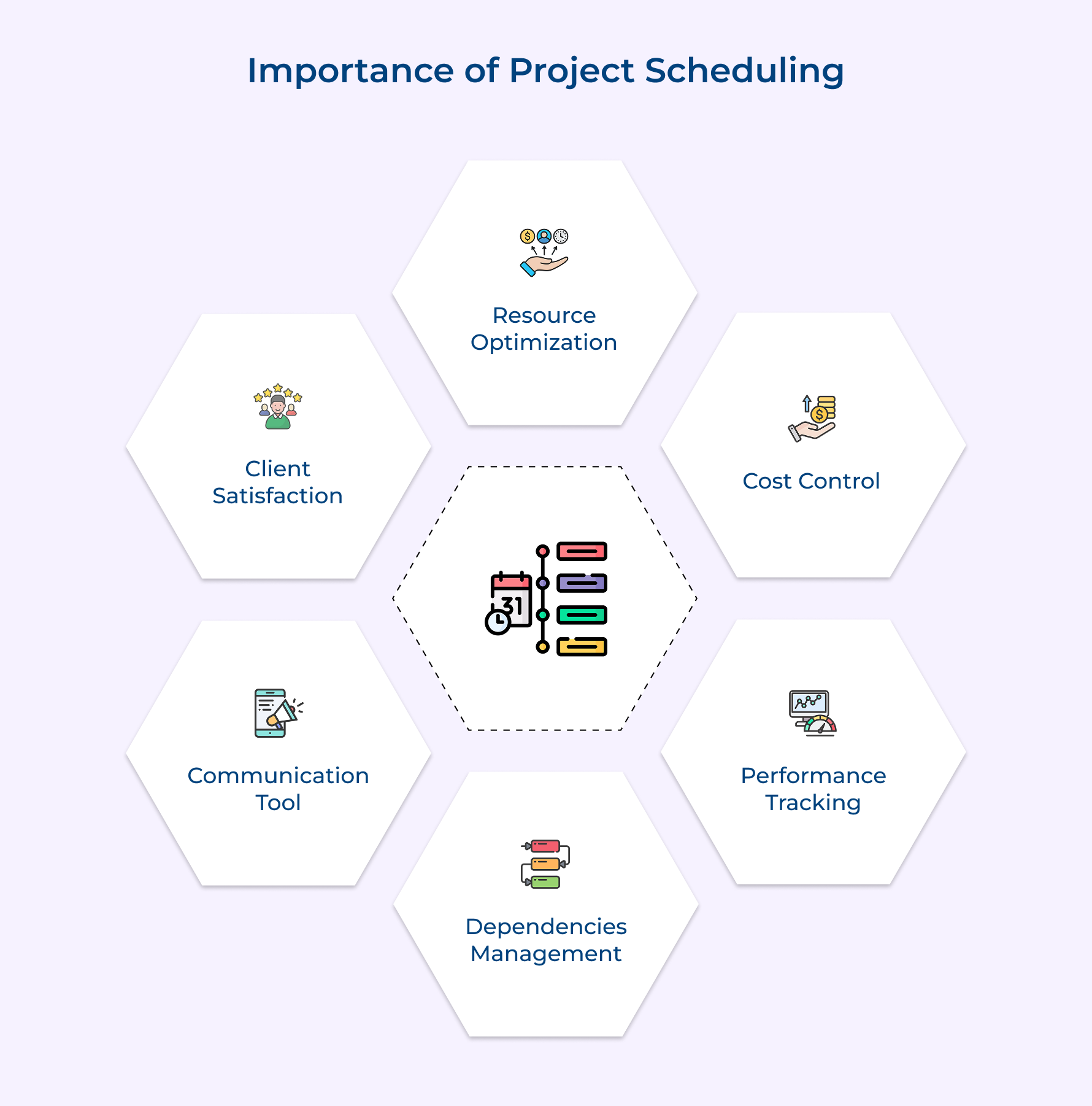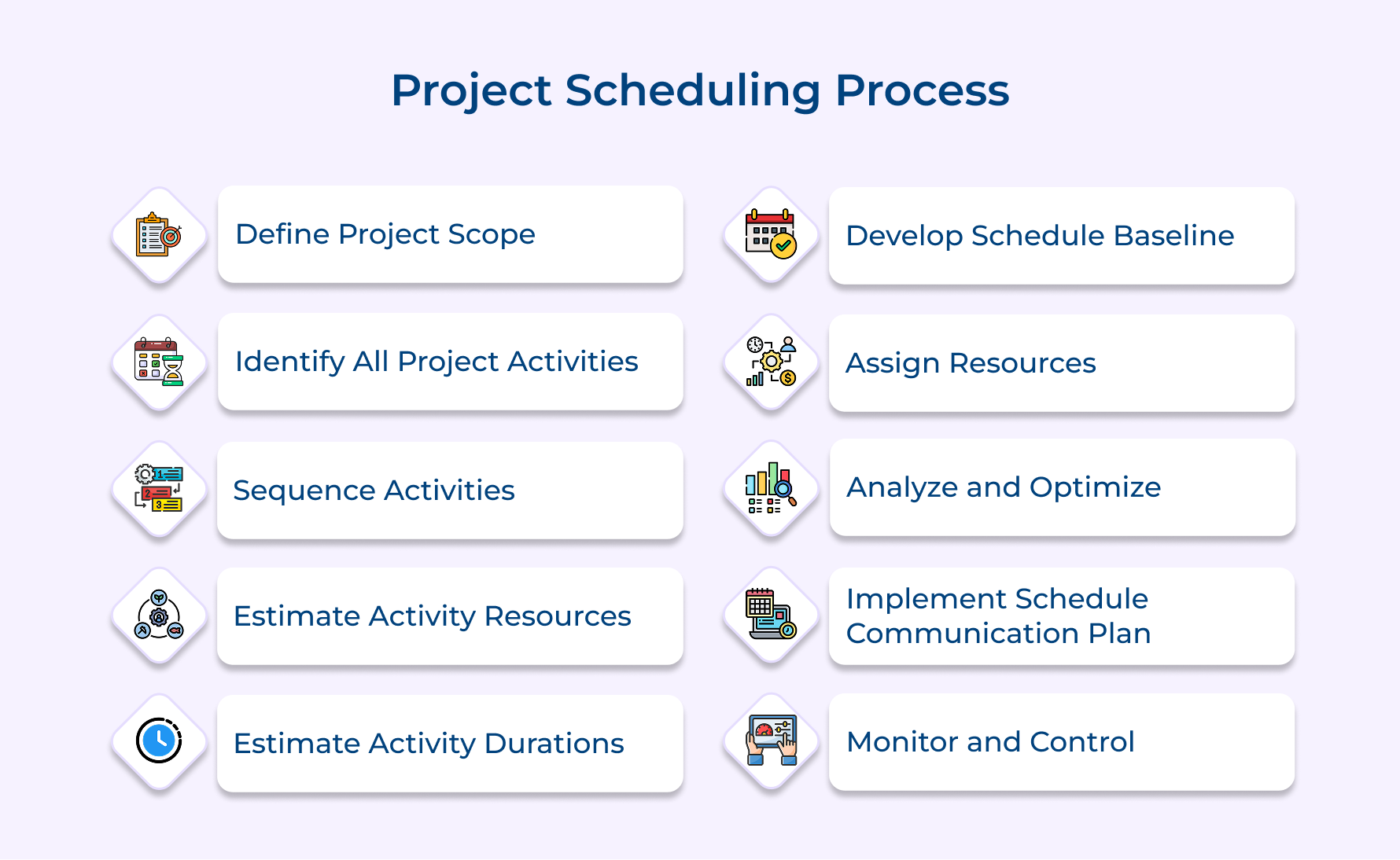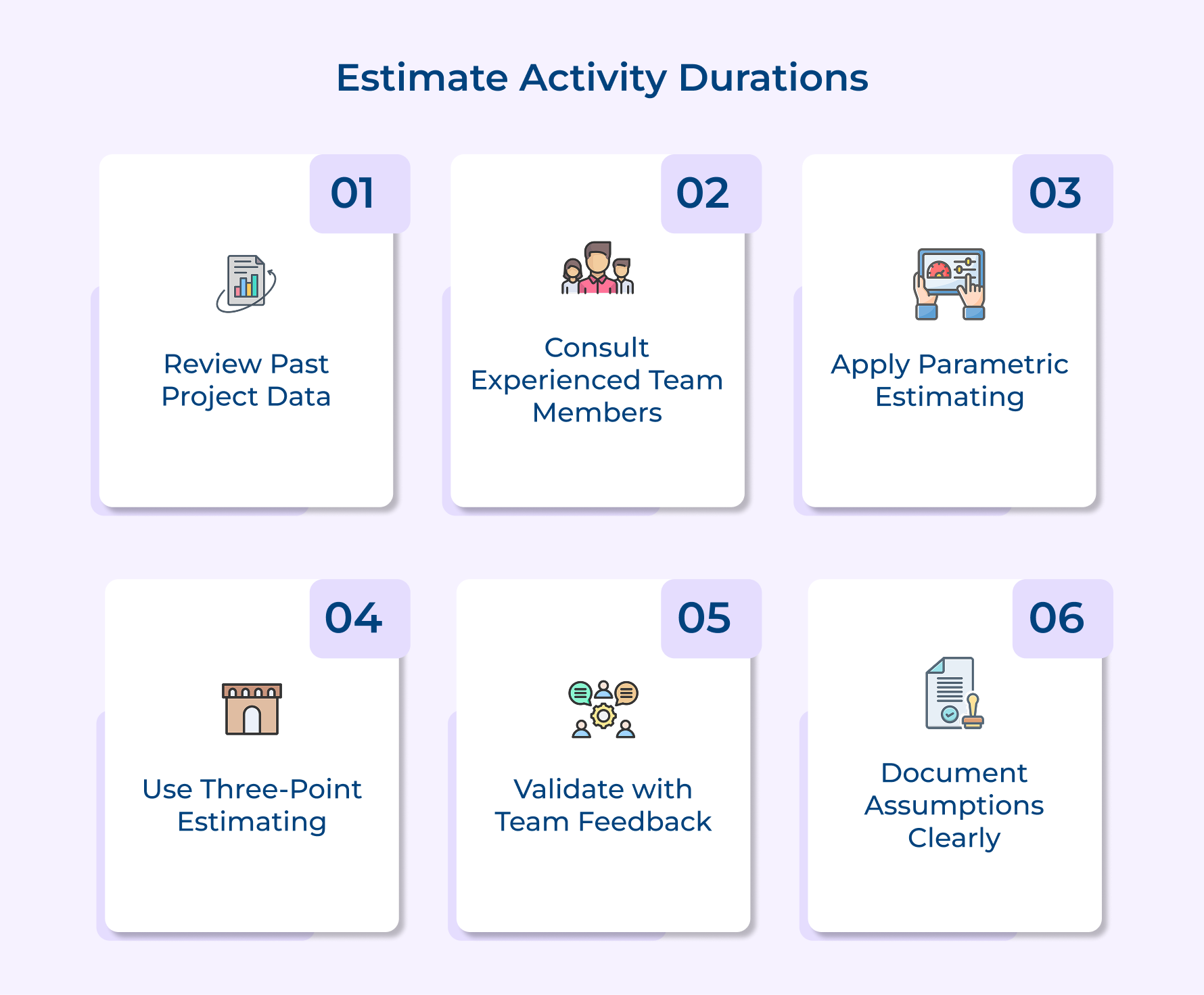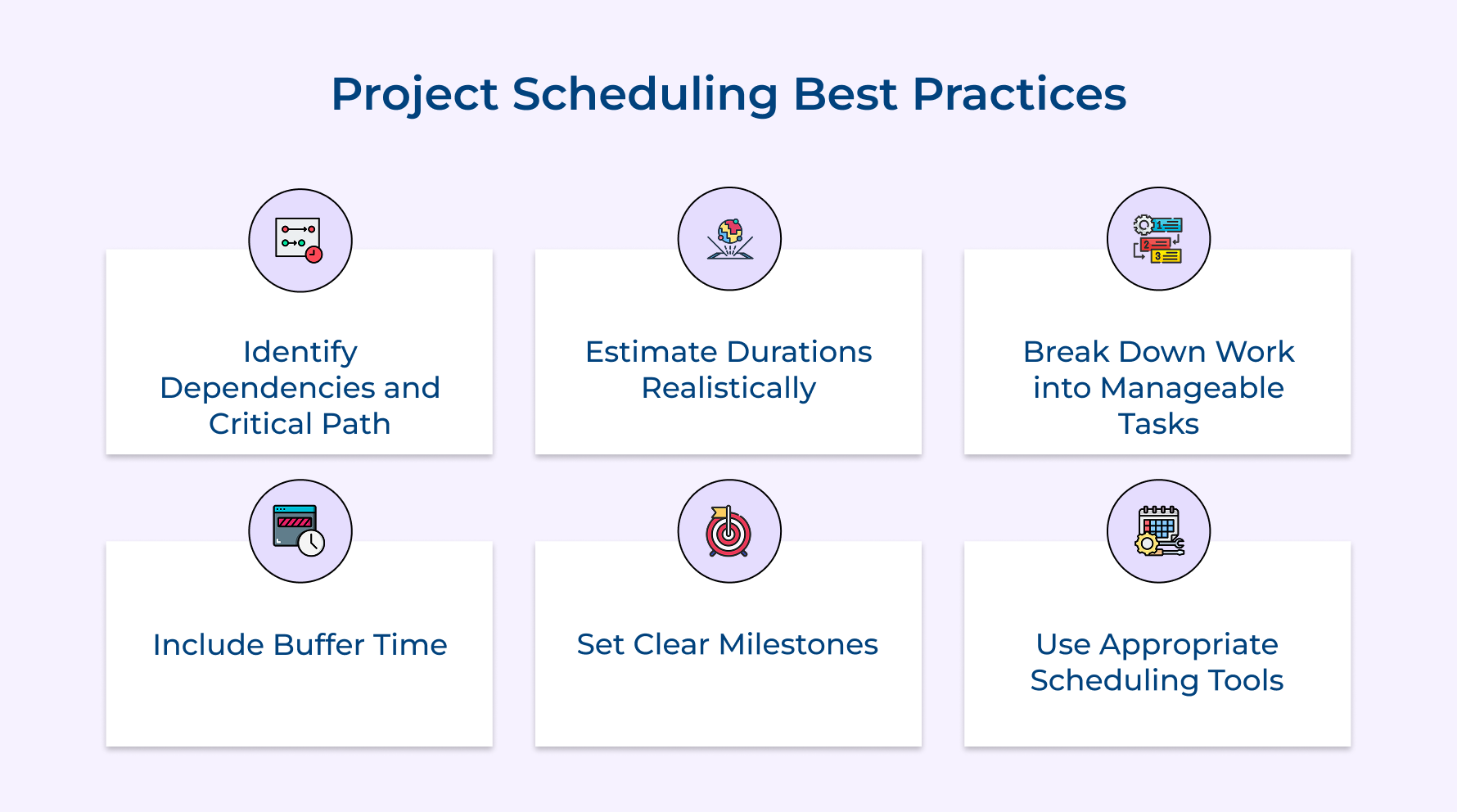A Complete Guide to Project Scheduling in Project Management

Key Highlights:
- Effective project scheduling ensures timely task completion, resource allocation, and deadline adherence, boosting productivity.
- Clear communication and collaboration streamline workflow, aligning teams with objectives while enhancing efficiency for successful project outcomes.
- Data-driven decision-making optimizes resource utilization, mitigates risks, and ensures adaptability.
Ever felt like your project is spinning out of control, deadlines slipping, resources stretched thin, and teams struggling to stay aligned? Poor scheduling is one of the biggest reasons projects go off track, leading to missed opportunities, frustrated teams, and unhappy clients.
Without a clear task list or a visual representation of the project flow, things can get messy fast. When done right, project scheduling brings clarity and ensures on-time delivery. It helps project managers allocate resources efficiently while keeping everything running smoothly.
In this blog, we’ll break down why mastering project scheduling is crucial and share key strategies to help you stay ahead.
What Is Project Scheduling?
Project scheduling is a systematic process of creating a detailed timeline that outlines when project tasks will be completed, what resources are required, and how different activities are interconnected. It serves as a comprehensive roadmap that determines start and finish dates for project activities, taking into account available resources as well as the overall project scope.
A well-crafted schedule helps project managers allocate resources efficiently, identify potential bottlenecks before they occur, and maintain control over project costs. It enables stakeholders to track progress, make informed decisions, and adapt to changes while keeping the project on course.
Key objectives:
- Setting realistic timelines and deadlines that align with project goals as well as resource availability.
- Optimizing resource allocation by identifying when specific skills and materials are needed throughout the project lifecycle.
- Facilitating effective risk management by highlighting critical paths and potential schedule conflicts that could impact project delivery.
- Enabling proactive decision-making by providing a baseline against which actual progress can be evaluated.
Why is Scheduling Important in Project Management?
Scheduling is the backbone of project management. It keeps tasks organized, deadlines on track, and resources optimized. Let’s explore how it is crucial for project management.
Resource Optimization
Without proper scheduling, some team members end up overloaded while others sit idle. A good schedule ensures that everyone (as well as everything) is utilized efficiently, preventing burnout and bottlenecks.
Cost Control
Blowing the budget? You don’t have to anymore! Scheduling helps track costs in real time so you can spot potential overruns early and adjust before things get out of hand.
Performance Tracking
A clear schedule shows where you are and what’s next. If things start slipping, you can take quick action to get back on course.
Dependencies Management
Some tasks can’t start until others are done. Scheduling keeps everything in order so you’re not stuck waiting for one task to finish before another can begin.
Communication Tool
No more “What’s the deadline again?” moments. A solid project schedule keeps teams aligned, ensuring everyone knows their responsibilities and key milestones.
Client Satisfaction
Meeting deadlines builds trust and strengthens client relationships. When your project runs smoothly, clients see you as reliable as well as professional, and that’s always a win!
How to Create a Perfect Project Scheduling Process: 10 Steps
Creating a flawless project schedule isn’t just about setting deadlines but also about building a roadmap that keeps everything on track. Follow these 10 essential steps to streamline your scheduling process and ensure project success.
Define Project Scope and Objectives
Imagine you’re planning a big family road trip. Before you start packing or mapping out the route, you need to decide where you’re going, how long you’ll stay, and what you want to do there. Without this clarity, you might end up with the wrong gear, unexpected detours, or worse—disappointed travelers!
The same goes for project scheduling. Defining the scope and objectives upfront ensures that everyone knows what the project will (and won’t) deliver. It prevents misunderstandings, wasted resources, and endless changes along the way.
Start by creating a detailed scope statement that outlines key goals, deliverables, and success criteria. Then, use this as a guide to break down tasks, estimate timelines, and set clear expectations. Before finalizing your schedule, review it with stakeholders to make sure everyone’s on the same page. A well-defined scope means fewer surprises and a smoother project journey!
Pro tips:
- Use the SMART framework (Specific, Measurable, Achievable, Relevant, Time-bound) when defining objectives and document them in a scope statement template.
- Create a scope boundary diagram highlighting both inclusions and exclusions, then review it with key stakeholders before proceeding.
Identify All Project Activities
Think of your project like assembling a giant puzzle, you need all the right pieces in place before you can see the full picture. That’s where activity identification comes in! It’s all about breaking down the project into smaller, manageable tasks so nothing gets overlooked.
- Break it down with a WBS: Start by creating a Work Breakdown Structure (WBS), a visual way to divide your project into major work packages and smaller tasks.
- List every activity: Under each work package, list out all the activities needed to complete it. Be as specific as possible, no task is too small!
- Get input from the team: Your team members and subject matter experts know the nitty-gritty details. Collaborate with them to ensure every critical task is captured.
- Spot dependencies early: Some tasks can’t start until others are finished. Identifying these dependencies now helps prevent scheduling hiccups later.
Pro tips:
- Use a combination of historical project templates and brainstorming sessions with team members to identify activities comprehensively.
- Create a responsibility matrix showing who will be involved in each activity’s execution and verification.
Sequence Activities
Now that you’ve listed all your tasks, it’s time to put them in the right order. Proper sequencing ensures that everything flows smoothly and prevents unnecessary delays. Here’s how to do it:
- Map out task relationships: Identify which tasks depend on others before they can start. Some tasks run in parallel, while others must follow a strict sequence.
- Create a visual flow: Use a network diagram to map out the order of activities and how they connect. This gives you a clear picture of how work will progress.
- Use scheduling software: Tools like Microsoft Project, Trello, or Asana can help you map dependencies and make adjustments as needed.
- Check with your team: Review the sequence with your team to ensure everything makes sense logically and find opportunities to optimize the workflow.
Pro tips:
- Use diagramming tools to visualize task relationships and validate them with subject matter experts.
- Document mandatory dependencies separately from discretionary ones to provide flexibility in schedule optimization.
Estimate Activity Resources
Ever started a DIY project only to realize halfway through that you’re missing a key tool? Frustrating, right? The same goes for project management—without the right resources at the right time, work comes to a halt.
Estimate accurately by,
- List out your resources: What will it take to get each task done? Think about people, equipment, materials, and even software.
- Check availability: Have you ever planned for a team member, only to find out they’re swamped with another project? Talk to team leads and department heads to confirm availability before locking in your schedule.
- Use past data: If you’ve worked on similar projects before, take a look at historical data to make more realistic estimates.
- Create a resource plan: Document all requirements so you can track availability and avoid last-minute surprises.
Pro tips:
- Create a resource breakdown structure that categorizes different types of resources needed for each activity.
- Develop a resource calendar showing availability and constraints for each resource type.
Estimate Activity Durations
Ever thought a task would take an hour but ended up spending half a day on it? That’s why estimating task durations accurately is crucial in project scheduling! It helps set realistic timelines, ensures efficient resource planning, and prevents frustrating delays.
To get the most accurate estimates, start by looking at historical data from similar projects. If you don’t have past data, consult with experts or team members who’ve handled similar tasks before. You can also use parametric estimating, a technique that calculates duration based on specific variables (like the number of people working on a task).
Once you’ve estimated durations, review them with your team to ensure they’re realistic. A well-thought-out duration estimate keeps your project running smoothly without last-minute surprises.
Tips:
- Use three-point estimating (optimistic, most likely, pessimistic) to account for uncertainty in duration calculations.
- Document assumptions and constraints used in each estimate for future reference as well as validation.
Develop Schedule Baseline
The schedule baseline is the approved version of the project schedule that serves as a reference point for measuring progress and tracking deviations throughout the project lifecycle.
The baseline provides a standard against which actual performance can be measured. It enables objective assessment of schedule variances, helps in identifying delays early, and supports effective project control as well as reporting.
Input all activities, durations, and dependencies into scheduling software to create a baseline. Use visualization tools like Gantt charts to communicate the schedule effectively to stakeholders.
Pro tips:
- Save multiple versions of the baseline during development and clearly label the final approved version.
- Create a baseline change log to track and document any approved modifications to the original baseline.
Assign Resources
Having the right people and tools for the job is like picking the perfect ingredients for a recipe, it makes all the difference. Proper resource assignment ensures tasks get completed on time without overloading your team.
- Match skills to tasks: Assign work based on who’s best suited for the job. The right skills lead to better efficiency and fewer errors.
- Check availability: Just because someone is skilled doesn’t mean they’re free. Look at resource calendars to avoid scheduling conflicts.
- Balance the workload: Use resource leveling to distribute work evenly—no one should be drowning in tasks while others have nothing to do.
- Optimize assignments: If a resource is overbooked, shuffle things around or adjust timelines to keep things realistic.
Pro tips:
- Create a RACI matrix (Responsible, Accountable, Consulted, Informed) for clear role definition.
- Implement resource calendars that account for holidays, vacations, and other commitments.
Analyze and Optimize
Creating a schedule is about making sure everything flows smoothly and efficiently. A well-optimized schedule helps you avoid risks, fix resource conflicts, and keep things on track.
- Identify the critical path: Figure out which tasks directly impact your project’s completion date. These are the ones you can’t afford to delay.
- Check for resource conflicts: Overbooked team members? Equipment unavailable? Spot issues early so you can adjust assignments before they cause bottlenecks.
- Apply resource leveling: Balance workloads to prevent burnout and ensure no resource is stretched too thin.
- Use schedule compression (If Needed): Tight deadline? Try fast-tracking (overlapping tasks) or crashing (adding extra resources) to speed things up—without compromising quality.
- Validate with your team: Before finalizing, review assumptions and logic with your team to catch errors while making improvements.
Pro tips:
- Use schedule compression techniques like fast-tracking and crashing where appropriate to optimize timelines.
- Conduct regular schedule health checks using predefined criteria and metrics.
Implement Schedule Communication Plan
A schedule communication plan outlines how schedule information will be shared, who needs to receive updates, and when communications will occur.
Effective schedule communication ensures that all stakeholders stay informed about progress, changes, and issues. It promotes transparency as well as helps maintain stakeholder engagement throughout the project.
Create a communication matrix specifying formats, frequency, and recipients. Establish regular schedule review meetings along with reporting cycles.
Pro tips:
- Develop different report formats tailored to various stakeholder groups’ needs and preferences.
- Set up automated schedule status notifications for key milestones and variances.
Monitor and Control
A schedule needs constant monitoring to ensure everything stays on track. Regular check-ins help spot delays early, so you can fix issues before they snowball.
Compare actual progress with your plan, analyze any gaps, and make adjustments as needed. Whether it’s reassigning tasks or tweaking deadlines, proactive monitoring keeps your project running smoothly and avoids last-minute chaos.
Pro tips:
- Use earned value management metrics to objectively measure schedule performance.
- Maintain a schedule risk log and review it weekly for potential impacts.
Project Scheduling Best Practices
Want to keep your projects running smoothly and on time? Following best practices in project scheduling helps you stay organized, minimize delays, and optimize resources.
Identify Dependencies and Critical Path
Map all task dependencies carefully and determine the critical path. Understanding which tasks affect others helps prevent bottlenecks and allows for better resource allocation. Regular review of dependencies ensures schedule accuracy.
Estimate Durations Realistically
Use historical data, expert judgment, and team input to create realistic task duration estimates. Consider factors like resource availability, complexity, and potential risks. Avoid overly optimistic timelines that could lead to delays.
Break Down Work into Manageable Tasks
Divide larger project components into smaller, measurable tasks using a Work Breakdown Structure (WBS). Ensure tasks are specific enough to estimate accurately but not so detailed that they become micromanagement challenges.
Include Buffer Time
Build reasonable buffer time into the schedule to account for unexpected delays or challenges. Place buffers strategically around high-risk activities and critical path tasks to maintain schedule flexibility.
Set Clear Milestones
Establish meaningful milestones throughout the project timeline. Use them to track progress, measure achievements, and maintain team momentum. Ensure milestones align with key deliverables as well as stakeholder expectations.
Use Appropriate Scheduling Tools
Select and utilize suitable project scheduling software. Ensure tools can handle project complexity as well as provide necessary features for tracking, reporting, and collaboration. Train team members in tool usage.
Common Challenges in Project Scheduling
Even the best project schedules can face roadblocks. From resource conflicts to unexpected delays, challenges can throw your timeline off track. Let’s look at some common scheduling hurdles and how to overcome them.
Scope Changes and Creep
Ever had a project where new requests keep popping up? Frequent scope changes can throw schedules off track, stretch resources, and inflate budgets.
To manage this, set up a clear change control process with approval workflows. Always assess how a change affects the timeline before giving the green light. Adding schedule buffers for unexpected tweaks can also help.
Poor Task Duration Estimates
If a task that was supposed to take a week suddenly drags into a month, you’ve got an estimation problem. Optimistic estimates often overlook complexity.
Use historical data, expert input, and proven estimation techniques like analogous or three-point estimating. Regularly reviewing estimates ensures better accuracy over time.
Limited Resource Skills
Imagine assigning a critical task, only to realize no one has the expertise to complete it. Skill gaps can cause major delays.
Cross-training your team, working with contractors, and building a skill database can help ensure resources are available when needed.
Schedule Monitoring Challenges
If you don’t know where your project stands, you can’t fix delays in time. Use earned value management (EVM) and project tracking software to monitor progress in real time.
Set up clear performance metrics and early warning systems so you can catch as well as resolve issues before they escalate.
Mastering Project Scheduling for Timely Delivery
Effective project scheduling is the backbone of successful project management. It not only ensures tasks are completed on time but also improves team collaboration, resource utilization, and overall efficiency.
A well-structured schedule helps project managers anticipate risks, manage workloads effectively, and make informed decisions to keep everything on track. By proactively addressing scheduling challenges and leveraging best practices, teams can avoid last-minute chaos as well as costly delays.
Investing time in proper scheduling sets the foundation for smooth execution, satisfied stakeholders, and high-quality results. With the right approach, your projects will stay on course, delivering success every time!
Limit time — not creativity
Everything you need for customer support, marketing & sales.
Neeti Singh is a passionate content writer at Kooper, where he transforms complex concepts into clear, engaging and actionable content. With a keen eye for detail and a love for technology, Tushar Joshi crafts blog posts, guides and articles that help readers navigate the fast-evolving world of software solutions.



